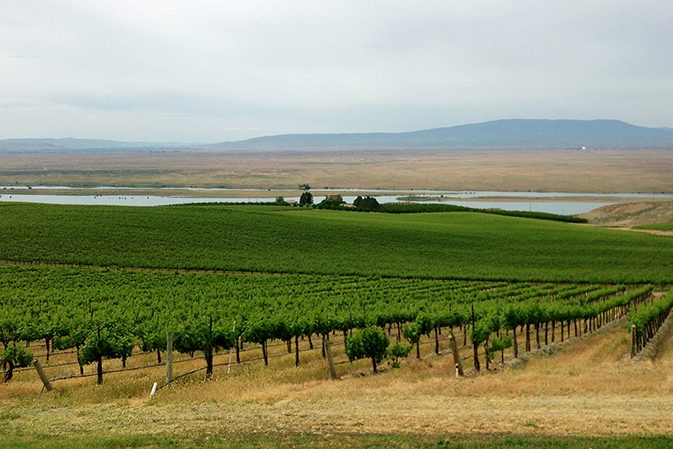
Home » New White Bluffs wine region will be north of Pasco
New White Bluffs wine region will be north of Pasco

December 16, 2019
By Andy Perdue
The Tri-Cities is philosophically and geographically in the heart of Washington wine country. And when the federal government approves a new American Viticultural Area north of Pasco, where some of the state’s oldest vines were planted nearly a half-century ago, the region’s position in the wine industry will be solidified.

Wine Press Northwest
The AVA system in the United
States is used to distinguish unique wine grape growing regions, ranging in
size from a single vineyard to millions of acres. Once approved, wineries can
list the AVA designation on their labels to help build credibility, enhance
value and as a marketing tool for wine that originates from that particular
growing area.
Washington state has 14 AVAs,
with the largest being the Columbia Valley, an 11-million-acre growing region
spanning from central Washington to northeast Oregon. The White Bluffs AVA
would be nested entirely within the Columbia Valley AVA, and its application
was submitted in 2017 by Kevin Pogue, a geologist at Whitman College in Walla
Walla. There would be 1,127 acres of vineyards within the 93,738 acres that
would span the White Bluffs AVA.
Around the world, these
grape-growing regions are known by different terms. In France, for instance, it
is an appellation. In Italy, it is a Denomination of Controlled Origin, or DOC.
In Canada and Australia, it is a Geographical Indication, or GI.
In the U.S., AVA names are
required to reflect the area’s history or geology. In the case of White Buffs,
it does both. The growing area sits on top of distinctive white bluffs in
Franklin County, overlooking the Columbia River. It also pays homage to the
town of White Bluffs, a former farming community just across the river in
Benton County. The town vanished in 1943, taken over by the federal government
during World War II for the Manhattan Project. Grapes for juice and wine were
known to be grown in the town’s surrounding agricultural area.
In the early days of the
Washington wine industry, there were few wineries and little in the way of
vines in the ground. By the 1960s, only a few vineyards existed in the Yakima
Valley and a few more were scattered across the state. There simply wasn’t much
supply for an industry that was poised to explode. It’s difficult to get a
viable industry started when raw materials are scarce.
The White Bluffs region proved
to be a turning point for the Washington wine industry. In 1968, a group of
investors led by Seattle attorney Alec Bayless bought land overlooking the
Columbia River north of Pasco. Four years later, the Texas native and his group
planted vines. It was a bold move, and it is difficult to say where
Washington’s wine industry would be if it never happened.
Their consultant was Walter
Clore, the researcher at Washington State University who came to be recognized
as the father of Washington wine, and Sagemoor Vineyard soon began to supply
the nascent wine industry.
Today, Sagemoor continues its
prominence, supplying grapes each fall to more than 100 Washington wineries.
Sagemoor comprises five vineyards: Sagemoor, Bacchus, Dionysus, Weinbau and
Gamache. All but Weinbau will be in the new AVA.
In 2014, Sagemoor Farms was
purchased from the remaining original owners by Allan Brothers, a
fourth-generation apple grower with headquarters near the town of Naches. In
2016, Sagemoor purchased the renowned Gamache Vineyards, a 220-acre site in
Basin City planted in the early 1980s. Gamache has a tasting room in Prosser’s
Vintner’s Village, with wine made by acclaimed Richland winemaker Charlie
Hoppes.
There’s more delicious history
surrounding this proposed AVA. In 1979, the Claar and Whitelatch families
established White Bluffs Vineyard just north of Sagemoor’s Dionysus block.
Crista Claar-Whitelatch and her husband, Bob, have since grown their family
plantings to nearly 140 acres, and Claar Cellars is the only winery within the
proposed AVA.
“We started calling our vineyards ‘White
Bluffs’ on our labels in 1998 because of the proximity to the White Bluffs,”
Claar-Whitelatch said via email.
Her parents homesteaded the
original farm, Unit 94, in 1950. Her grandfather, Ed Albro, bought nearby Unit
206 overlooking the Columbia River because of his love for the area. History
has proven Albro to be a visionary.
“I was told that in the early
’50s, he stood on the bluff and said, ‘This will be vineyard one day!,”
Claar-Whitelatch said.
• • •
Palencia Winery’s 2016 Casa
Amarilla, a red blend, was named a Seattle Times Wine of the Year. The blend of
Grenache, Syrah and Mourvèdre uses grapes from the Yakima Valley. It retails
for $36 at Victor Palencia’s tasting rooms in West Richland and Kennewick’s
Columbia Gardens Urban Wine and Artisan Village.
• • •
Maryhill Winery in Goldendale,
one of Washington’s largest and most-visited wineries, opened a new tasting
room Nov. 14 in Woodinville’s historic Hollywood Schoolhouse near Chateau Ste.
Michelle. This makes a hat trick of satellite tasting rooms because owners
Craig and Vicki Leuthold also have retail locations in Spokane and Vancouver.
Andy Perdue, editor and publisher of Great Northwest Wine and founding editor of Wine Press Northwest magazine, is the wine columnist for The Seattle Times.
Local News
KEYWORDS december 2019




